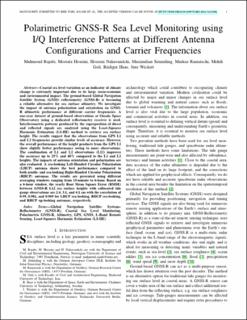| dc.contributor.author | Rajabi, Mahmoud | |
| dc.contributor.author | Hoseini, Mostafa | |
| dc.contributor.author | Nahavandchi, Hossein | |
| dc.contributor.author | Semmling, Maximillian | |
| dc.contributor.author | Ramatschi, Markus | |
| dc.contributor.author | Goli, Mehdi | |
| dc.contributor.author | Haas, Rudiger | |
| dc.contributor.author | Wickert, Jens | |
| dc.date.accessioned | 2022-04-01T11:58:07Z | |
| dc.date.available | 2022-04-01T11:58:07Z | |
| dc.date.created | 2021-12-04T15:18:48Z | |
| dc.date.issued | 2021 | |
| dc.identifier.citation | IEEE Transactions on Geoscience and Remote Sensing. 2021, . | en_US |
| dc.identifier.issn | 0196-2892 | |
| dc.identifier.uri | https://hdl.handle.net/11250/2989285 | |
| dc.description.abstract | Coastal sea level variation as an indicator of climate change is extremely important due to its large socioeconomic and environmental impacts. The ground-based global navigation satellite system (GNSS)-reflectometry (GNSS-R) is becoming a reliable alternative for sea surface altimetry. We investigate the impact of antenna polarization and orientation on GNSS-R altimetric performance at different carrier frequencies. A one-year dataset of ground-based observations at the Onsala Space Observatory using a dedicated reflectometry receiver is used. Interferometric patterns produced by the superposition of direct and reflected signals are analyzed using the least-squares harmonic estimation (LS-HE) method to retrieve sea surface height. The results suggest that the observations from global positioning system (GPS) L1 and L2 frequencies provide similar levels of accuracy. However, the overall performance of the height products from the GPS L1 shows slightly better performance due to more observations. The combination of L1 and L2 observations (L12) improves the accuracy up to 25% and 40% compared to the L1 and L2 heights. The impacts of antenna orientation and polarization are also evaluated. A sea-looking left-handed circular polarization (LHCP) antenna shows the best performance compared to both zenith- and sea-looking right-handed circular polarization (RHCP) antennas. The results are presented using different averaging windows ranging from 15 min to 6 h. Based on a 6-h window, the yearly root mean squared errors (RMSEs) between GNSS-R L12 sea surface heights with collocated tide gauge observations are 2.4, 3.1, and 4.1 cm with the correlation of 0.990, 0.982, and 0.969 for LHCP sea-looking, RHCP sea-looking, and RHCP up-looking antennas, respectively. | en_US |
| dc.language.iso | eng | en_US |
| dc.publisher | Institute of Electrical and Electronics Engineers (IEEE) | en_US |
| dc.title | Polarimetric GNSS-R Sea Level Monitoring using I/Q Interference Patterns at Different Antenna Configurations and Carrier Frequencies | en_US |
| dc.type | Peer reviewed | en_US |
| dc.type | Journal article | en_US |
| dc.description.version | acceptedVersion | en_US |
| dc.rights.holder | © IEEE. Personal use of this material is permitted. Permission from IEEE must be obtained for all other uses, in any current or future media, including reprinting/republishing this material for advertising or promotional purposes, creating new collective works, for resale or redistribution to servers or lists, or reuse of any copyrighted component of this work in other works. | en_US |
| dc.source.pagenumber | 16 | en_US |
| dc.source.journal | IEEE Transactions on Geoscience and Remote Sensing | en_US |
| dc.identifier.doi | 10.1109/TGRS.2021.3123146 | |
| dc.identifier.cristin | 1964695 | |
| cristin.ispublished | true | |
| cristin.fulltext | postprint | |
| cristin.qualitycode | 2 | |
